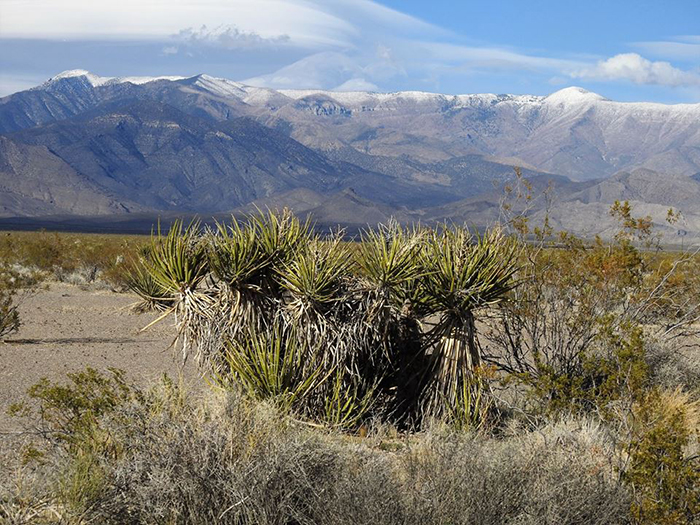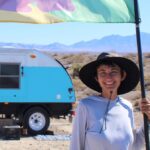Where is the people’s solar?

Most of you have seen images of the industrial-sized solar arrays promised to solve the existential threat of climate change. For those who haven’t, picture a desert vista: Big, blue sky; purple mountains all around; a vast valley covered with dizzying rows of black solar panels elevated a few feet off the ground. Look closely and you’ll see that the earth beneath the solar panels has been scraped, graded and sprayed with herbicide. The land’s natural washes are all filled in, too.
There is much you won’t see at an industrial solar array. The kit foxes are gone. The ancient plants are also gone — the creosote, the yuccas, the Joshua trees. The barrel cactus, too. The fungus, lichen and moths. What geologists call “desert pavement”—an intricate formation of stones locking down sand since the days it was trod upon by giant ground sloths—has been destroyed. What’s left the locals call “poof dirt,” dust that weighs practically nothing.
We have learned a lot about desert ecology since the first industrial-scale solar facilities were built here a decade ago. We now know that just as tree forests are interconnected, much of the Mojave Desert is latticed with a microbial crust, the soil alive with networks of lichen and fungus that feed off both the sun’s light and the moon’s. In many parts of the Mojave, the lichen and moss are visible as black, sponge-like splotches on the surface of the desert floor, becoming dazzling shades of blue and green in wet years. This crust allows the desert to resurrect itself with each rain.
We also now know that some fungus unleashed by reckless construction practices can cause a respiratory illness called Valley fever. We also know that migrating birds can mistake solar arrays for lakes, landing there and never alighting again. Sometimes, as they descend, the birds combust in mid-air from the heat. We know that industrial solar storage uses a lot of water. And we know that intact deserts, much like woodlands, wetlands and prairie, are storing carbon, sequestering it. They do this through their soil’s microbial networks.When disturbted, the carbon is released.
When you gaze upon an industrial solar array in the American desert, you are often seeing land that was, until very recently, our commons, now ruined forever. You are also sometimes seeing the sacred ancestral homeland of the Nuwu (Southern Paiute) people, whose descendants still live here and throughout the Mojave Desert.
The Bureau of Land Management’s Solar Energy Environmental Mapper reveals that most of the nearly pristine public land across the Mojave Desert and the Great Basin could potentially be sold off in the green energy “gold rush” for solar arrays, wind farms and mines. The story is much the same across the rest of the Southwest. Should this green future come to pass on our arid lands, it could bring apocalypse for the desert.
We need renewable energy infrastructure. That’s inarguable. But we need to build it wisely and justly. To actually transition off of fossil fuels will take an evolved environmental ethic informed by indigenous wisdom and the latest scientific knowledge, along with an understanding of the deserts of the American Southwest as home to vast old-growth forests still keeping us alive, not as wastelands awaiting plunder.
What many think is nothing more than a vast expanse of dirt and weeds is almost shockingly, beautifully alive. Depending on your elevation, there is creosote, Mojave yucca, cholla cactus, ocotillo, the beloved Joshua tree, pinyon and juniper, desert willow, and many more plant species that evolved to thrive in exactly this environment. These plants support animal life from every kingdom: reptiles, insects, birds, mammals, even fish. There are tortoises, badgers, foxes, deer, wild horses, bighorn sheep, and mountain lions all living off the land that most will never see.
For the Nuwu, who have lived here for centuries, every inch of this living landscape carries the cultural and ecologic stories, histories, and features of their tribe’s sacred song cycles, which are spelled out in geographies and ecologies throughout the Mojave Desert, including southeastern Nevada, southwestern Utah and northwestern Arizona. According to tribal leader and singer Matthew Leivas, Sr., the songs of the sacred Salt Song Trail are at the core of Nuwu culture, forming a ceremonial song trail that connects sacred places and locations into a long, continuous loop, and reveals the complex relationship between people, place, and story.
Large-scale industrial projects such as Yellow Pine Solar in Pahrump Valley are a desecration and erasure of the Nuwu people and their songs and cultural landscapes; this, following several centuries of federal land-use policies that have already significantly diminished and destroyed a majority of these sacred places.
Throughout the Nevada and California desert, the push to build utility-scale “clean energy” projects led to many of them being fast-tracked. Some “Fast-41” projects were pushed through during the height of the coronavirus without even virtual public meetings. Yellow Pine is being rushed along, too. Its developer, Florida-based Nextera Energy, is one of the largest energy conglomerates in the world. The Yellow Pine array will destroy—that is, bulldoze and grind up—approximately 90,000 Mojave Yucca and all the creatures living in and near them: desert night lizards, snakes, rodents, pollinating moths.
These yucca—termed “forest products” by the BLM (further evidence that the desert is a kind of forest)—are cherished by the region’s indigenous people, including the Nuwu and Timbisha Shoshone. Some yucca are potentially thousands of years old. Imagine the tragic folly of mulching 90,000 giant sequoias, redwoods or ancient bristlecone pines for an inefficient, inequitable industrial solar array sending energy to cities and companies far away.
At Yellow Pine, we don’t have to imagine. In May of this year, 139 desert tortoises were dug up from their burrows and relocated across a highway, a process mandated by their protected status. Conservation biologists like those at the nonprofit Basin and Range Watch (one author of this piece, Ruth Nolan, serves on the board) were not optimistic for the chances of the displaced tortoises, who spend their entire lives in an intimately memorized range of just one square mile. The carnage was worse even than friends of the tortoise feared: 26 were promptly eaten by badgers. Ours is an era of mass extinctions. We do not have spare tortoises or disposable swaths of habitat.
The irony of these industrial solar arrays turning the desert into the wasteland that many people assume it must already be is that today (after a few hundred years of colonialism’s extractive ecocide), large swaths of this land are already effectively wasted. Military bases, sprawling cities, spent agricultural fields and ranch land, roasting parking lots, mile upon mile of highways and evaporating irrigation canals—all of these could and should be considered as sites for solar arrays before we think of sacrificing another acre of public wilderness.
We can’t simply switch over to vast solar grids that decimate what is left of our desert ecosystems. It’s not only wrong; it won’t work. These huge, remote facilities require vast transmission lines across multiple states, which, as a recent New York Times article pointed out, cause wildfires, which clear forests, and even without disasters lose some of the electricity they are carrying. For-profit industrial solar is not good enough, and a surprising number of coalitions in many communities are already rejecting it.
Too much of the conversation around our response to climate change accepts a dangerous false binary between so-called “green energy” and biodiversity—a devil’s bargain threatening to divide the environmentalist community. This surely delights the energy executives and politicians beholden to them, but our children will not enjoy zipping around in their electric vehicles if they do not have clean air and water and natural ecosystems. And incremental blunders like Yellow Pine will squander the few years we have left to act.
The industrial path we are on degrades the land — and with it, the human spirit. It is the wild within the human mind that we stand to lose, as much as the wild outside. The land embodies the sacred archaeologies and cultural integrities of our indigenous people and their legacies. When we invite these companies to raze the land, we not only exacerbate the rural-urban divide that makes so many of our politics so dysfunctional, but we also ransom our very souls. All for what? Jobs? Nextera recently boasted to the Las Vegas Review-Journal that Yellow Pine will create “300 construction jobs,” neglecting to note that those jobs are temporary. According to BLM’s environmental impact statement, the completed array facility will employ “up to 10 employees” — but that “it is possible that the facility could be operated remotely without permanent staff on-site,” meaning Yellow Pine “would not appreciably change existing economic conditions in the analysis area.”
The Biden Administration must stop genuflecting to an energy industry that has, for the last four decades, knowingly contributed to and profiteered from the climate crisis. Rather than “fast-track” massive destruction in America’s outback, the administration should fast-track a people’s solar: public, distributed solar atop the built environment, where it is used. Why not turn NIMBYs into YIMBYs with policies that install solar arrays on existing rooftops throughout this sun-abundant region at no cost to the consumer, rather than subjecting them to the current over-complicated system of rebates and other abstract pseudo-incentives rife with scam?
We imagine the existing infrastructure of Southern Nevada enhanced by large solar canopies shading the giant parking lots at WalMart, Downtown Summerlin, UNLV, valley parks and the vast military complexes throughout this desert. We could enjoy shade as we walk into our strip malls, all while preserving the life-sustaining, carbon-sequestering capacity of our great desert.
The remaining south Pahrump valley surrounding Yellow Pine Solar (where five other solar projects are proposed) is but one site where we still have a chance to refuse wasteful, outdated, exploitative and destructive industrial supply chains. It is also just one strand of a conversation we must have about how to realistically and systematically rearrange society to use less. Solutions for a livable planet will not be the easiest, the cheapest, or the most profitable for executives and shareholders. Fighting for our future means a reimagining of our whole economic order.
Let’s start with the parking lots.
Ruth Nolan is a lifelong Mojave Desert resident and former wildland firefighter for the Bureau of Land Management's CA Desert District. She is Professor of Creative Writing and English at College of the Desert and California Indian Nations College, and editor of No Place for a Puritan: the Literature of California's Deserts.
Shannon Salter is a writer and activist in the Mojave Desert of Nevada and California. She is currently bearing witness to the destruction at the Yellow Pine Solar facility in the South Pahrump valley.
Claire Vaye Watkins is the author of three works of fiction: Battleborn, Gold Fame Citrus, and I Love You But I've Chosen Darkness. She is a professor in the Programs in Writing at the University of California, Irvine and lives in the Mojave Desert.


